When the great Soviet writer Viktor Astafyev was finishing writing his literary masterpiece in 1975 – the novella “Czar Fish” (Kingfish) – most likely he didn’t even assume that this was not the way the sturgeon was called on the Adriatic shores of Croatia and Montenegro. This was the name of a representative of the Sparidae family or sea breams.
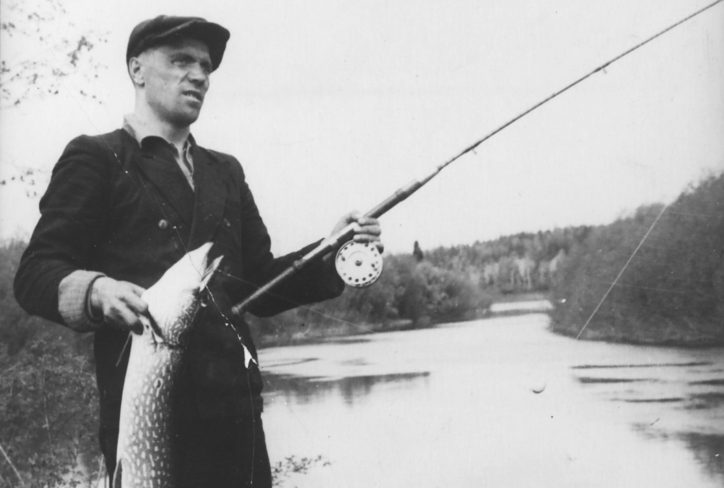
(Viktor Astafyev, 1954. Photo by © archive.perm.ru)
In thesecond part of the article, adriaticnature attempted to sort out sea breams, which are most often caught by “coastal” Adriatic fishermen, saddled seabreams, slippery and greedy predators in stormy weather, having mentioned the most popular “sea bream” — gilthead bream in the first one.
However, perhaps, the most frequent “sea breams” are the small fish caught from the rocks or piers by the fans of float gear, bogues. These fishermen insist that this fish is extremely tasty.

(Bogue. Picture by © Rui Patricio Freitas. fishbase.org)
Bogues may be 36 centimeters long and weigh 500 grams, but specimens up to 20 centimeters are more common. This is the schooling fish that inhabits the sea 5 meters deep, often over a plant filled rocky or muddy bottom. When the water becomes warmer, it swims away from the shore, and vice versa, when it becomes colder.
It prefers baits of animal origin, as well as bread to artificial lures. Bread, especially cheese or pilchard flavored one, or small shrimps on the hook are dietary preferences of bogues.
If you find clusters of bogues and enjoy “peaceful” fishing, you can combine the pleasure of the fishing process with the gastronomic one.
The second most frequently caught sea bream is probably a annular seabream. Bread or mollusk flesh is an excellent lure for it. Nevertheless, this fish is quite accessible to the fans of a “light” spinning rod as well.
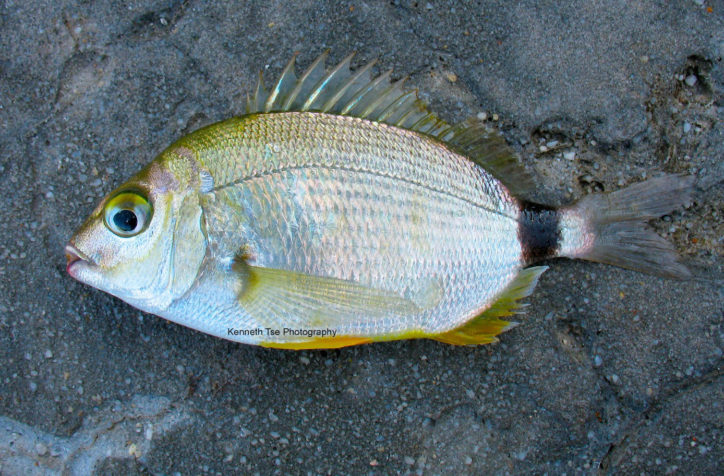
(Annular seabream. Photo by © Kenneth Tse. muskiebaitadventures.blogspot.com)
Annular seabream like all the small soft plastic lures on light jig-heads, “edible” rubber, stuff like that. However, it may inconvenience a little bit as well. The annular seabream bites off miniature soft plastic lures with its small mouth, or rather with its small but sharp teeth, with a bang. Especially, when it’s in the mood of just “picking” – catching and slightly biting the lure. But when it really wants to eat, one can catch a fair amount of this medium-sized fish, the maximum size of which is about 25 centimeters.
The fishermen, who prefer catching fish with artificial lures, often come across a rather cute sea bream called salema. This fish prefers algae and is extremely rarely interested in artificial lures.

(Salema. Photo by © newsmobile.in)
Nevertheless, salemas get interested in the lures of natural origin. They are usually caught with bread, mixed with algae. If you intend to give up on the “catch and release” principle, it is suggested to scale the fish on the sea immediately after fishing, as well as in cases of all inhabitants that feed on algae. The processes of disintegration start quickly in the gastrointestinal tract of the caught fish, the tissues of the abdominal cavity begin to adsorb decay products, making the cooked dish bitter flavored.
Gustatory qualities of the fish are highly appreciated. However, two cases of poisoning after eating salema have been recorded, which were manifested in subsequent auditory and visual hallucinations that have lasted for a very long time. Scientists relate the incidents to algae – the main feeding stuff of salps.
The fish may be half a meter long, but more often specimens rarely exceed 30 centimeters.
The sand steenbras, or the striped sea bream, looks rather peculiarly as well: it has transverse bars on the body and the head that resembles a sheep head a little. That’s the reason why this fish got one of its names ovčica – the sheep – on the Montenegrin-Croatian-Slovenian shores.

(Sand steenbras. Photo by © Marrabbio2. wikipedia.org)
This sea bream may be 55 centimeters long and weigh about a kilogram; usually the fish up to 30 centimeters is caught. It feeds on marine worms, mollusks and crustaceans.
The sand steenbras is a schooling fish, which prefers to feed above the sandy bottom in those areas where it borders with stony ridges or underwater rocks. Evening and tides are a great combination to try and find the sand steenbras. It is the bottom feeder, so one should try suggesting the lures near the bottom. Speaking about baits of animal origin, shrimps, marine worms, mussels, squid pieces can be used.
The sand steenbras attacks artificial lures with pleasure as well. Small soft plastic lures are preferred. When several specimens are caught, they are the by-catch. But it happens rarely.
Fishermen catch a lot of sea breams in the Adriatic Sea, and they often cause confusion. All of them are somewhat similar at first glance, but it’s only the first impression.
Two black stripes – one above the operculum and the other near the tail – make the common two-banded seabream, different from the annular seabream.
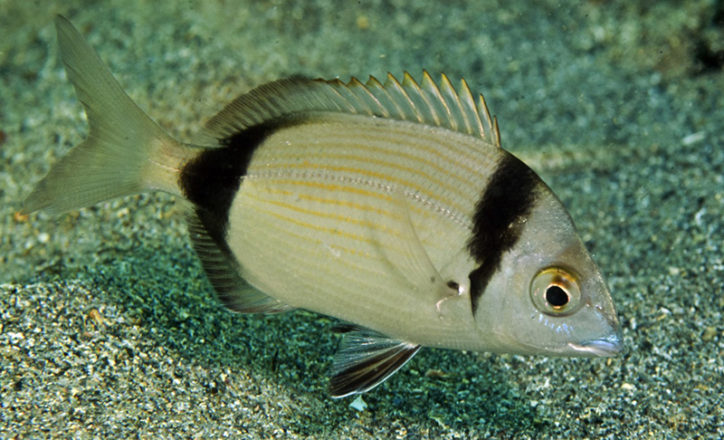
(Common two-banded seabream. Photo by © Nuno Vasco Rodrigues. berlengas.eu)
The two-banded seabream may weigh more than a kilogram, smaller specimens are more common. This sea bream, like the sand steenbras, feeds on marine worms, mollusks and crustaceans. It prefers to stay close to the rocky bottom at depths of more than 5 meters. By the end of summer and at the beginning of autumn, the two-banded seabreams begin to gather in larger schools, preparing for spawning, which occurs in winter. September is considered to be the best month to catch the sargue.
Baits and lures for two-banded breams are the same as forsand steenbrases. However, two-banded breams are faster than sand steenbras and are often interested in medium-sized jigs and small plugs, in addition to various soft plastic lures.
Another sea bream has even more predatory tendencies than the two-banded bream. It is the white seabream.

(White seabream. Photo by © Citron. wikipedia.org)
It may weigh almost 2 kilograms, specimens up to 600-700 grams are more common. The white bream feeds on mollusks and other sediment dwellers and doesn’t neglect eating small fish.
Its predatory inclinations are often manifested in moments of rise and fall of the waves, when the white bream begins to hunt the fry actively in the coastal foam and twists around the rocky shores. It also attacks medium-sized jigs, plugs, and soft plastic lures with pleasure.
Playing of the light gear with this strong fighter may be a lot of fun. The mollusk flesh is considered to be one of the best baits for catching white breams with float or leger rigs.
The black seabream is a numerous species in the Adriatic Sea, but the fishermen, who practice fishing at the shore, don’t often come across this fish.

(Black seabream, a young specimen. Photo by © Fabio Crocetta. naturamediterraneo.com)
The thing is that black seabreams, especially adult representatives of the species, inhabit a fairly deep sea. They swim close to the shores rarely and in small quantities. In spring, they gather in large schools, preparing for spawning. In this case, catching black sea breams from the boats at depths ranging from 20-30 meters can be quite successful.
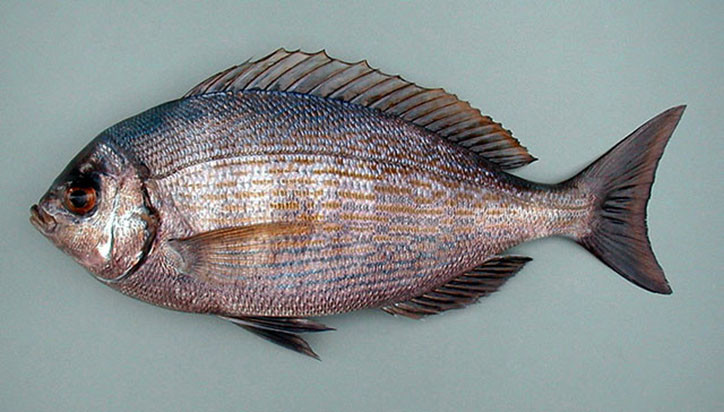
(Black seabream, an adult specimen © Pedro Niny Duarte(c)ImagDOP. fishbase.org)
However, occasionally the black seabream still swims close to the shore. More often it can occur in rather deep areas. Due to the fact that this fish has a very small mouth, it’s better to use small hooks when catching it. As for the baits, the black sea bream is rather omnivorous.
Occasionally, the black sea bream is caught with a spinning rod: small soft plastic lures, as well as small plugs and compact topwater lures – walkers and poppers.
Young specimens of the black sea bream are very similar to the juveniles of another sea bream – the sharpsnout seabream, while the way adult specimens of the sharpsnout seabreams look is a mixture of features of the sand steenbras and the white bream.
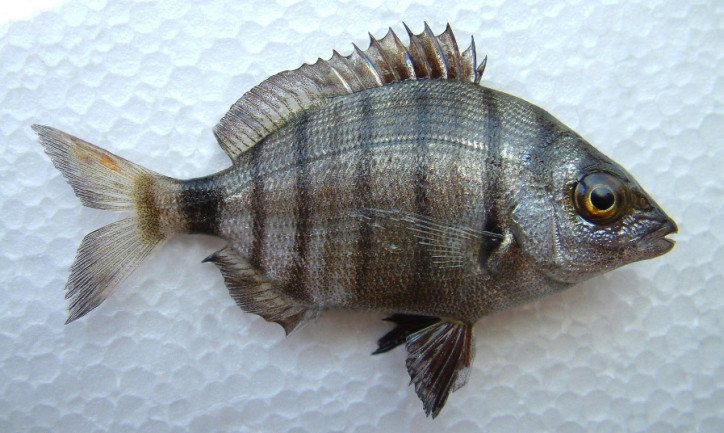
(Sharpsnout seabream, a young specimen. Photo by © Fabio Crocetta. naturamediterraneo.com)
The sharpsnout seabream may weigh two kilograms, more often the specimens weigh up to a kilogram. It is a rather undemanding fish, which can be caught from May till autumn in the places, inhabited by the gilt-head seabreams as well.

(Sharpsnout seabream, an adult specimen. Photo by © turkishseafoods.com)
The sharpsnout seabream differs from other sea breams by the fact that its head has an extraordinary shape. If you have good imagination, the mouth of the fish can really look a bit like a beak to you.
It feeds on algae, mollusks, worms, shrimps, and occasionally small fish. Most often it is caught with baits of natural origin, more rarely – with soft plastic and other medium-sized artificial lures.
Several sea breams differ from other representatives of this family in a pinkish body color.
Common pandora, may be 60 centimeters long and weigh more than 2 kilograms; when fishing at the shore, fish up to 300-400 grams are more common.

(Common pandora. Photo by © Fabio Crocetta. naturamediterraneo.com)
This lively common pandora prefers to stay at depths of more than 30-40 meters. Besides, it likes deep large sea bays, where it swims close enough to the coast quite regularly. It is omnivorous, so the choice of natural bait is up to the fisherman, including shrimp, squid pieces and so on.
Since the fish sticks to the bottom, leger rigs or feeders are the best choice for fans of “peaceful” fishing, while soft plastic lures with the following closer to the bottom are better for fishermen, who prefer fishing with artificial lures.
The common pandora is somewhat similar to juveniles of other sea breams, which should be protected. The red porgy is a desired trophy for the Mediterranean anglers.
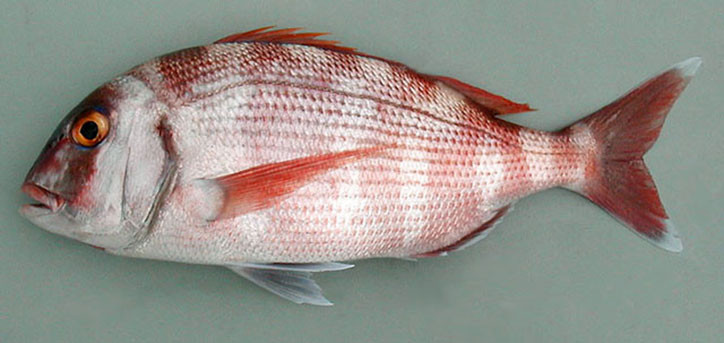
(Red porgy. Photo by © Pedro Niny Duarte(c)ImagDOP. fishbase.org)
This sea bream may weigh 10 kilograms, but specimens up to 3-5 kilograms are more common. It’s better to catch them from boats, since with age these porgies swim farther from the coast to depths of 200-250 meters, preferring hundred-meter marks.
The fish weighing up to 700-800 grams mainly stick close to the shore. Small specimens should be released. The red porgy is a leisured omnivorous predator. It feeds on squids, fish, mollusks, crustaceans. Squid is one of the favorite baits. When you fish with spinning rods, porgies can be caught with jigs, soft plastic and other artificial lures, which in most cases should be followed near the bottom.
The red porgy has a characteristic distinctive feature – the tips of the caudal fin are white.
One of the most valuable fish in the Mediterranean Sea, or rather one of the most valuable sea breams, including the gilt-head bream, is the сommon dentex.
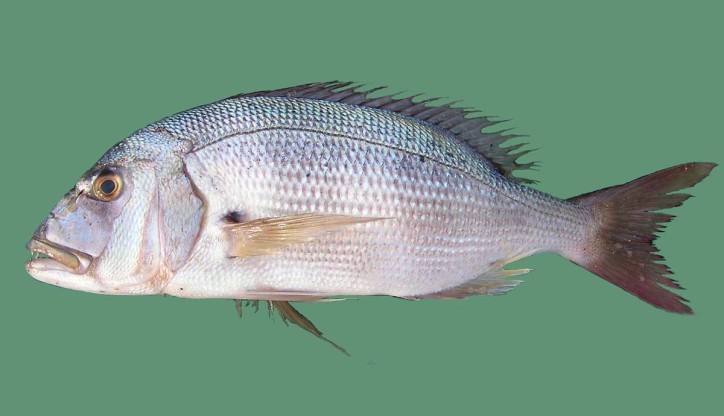
(Common dentex. Photo by © Jiří Novák. biolib.cz)
On the northern shores of the Adriatic Sea, fishermen call this fish modestly “Car”, which translated as “King” from the Serbian-Croatian language. The king of sea breams may be up to a meter long and weigh 14 kilograms.
This fish got its name common dentex, or Dentex dentex in Latin, for the pronounced “fangs” located on the upper and lower jaws, making it look a little like a dog or a wolf, but rather like a made up predatory beast.
The gustatory qualities of the common dentex are highly appreciated, the fish is considered to be one of the most desired fishing trophies. However, small dentexes, which will become truly royal fish in the future, should definitely be released back in water.
Unlike its relatives, red porgies, dentexes, weighing up to 7-8 kilograms, often hunt in the coastal zone. They are more often caught in autumn and spring. They are willing to catch jigs, rather large soft plastic and other lures, which are followed near the bottom. Squid-shaped bait is perfect for fishing with leger rigs with natural lures.
The pink dentex is the closest relative of the common denrex. It weighs a lot – 17 kilograms – but it is less common than its relative. A bony wart on the forehead, which becomes more pronounced with age, is its peculiar feature.
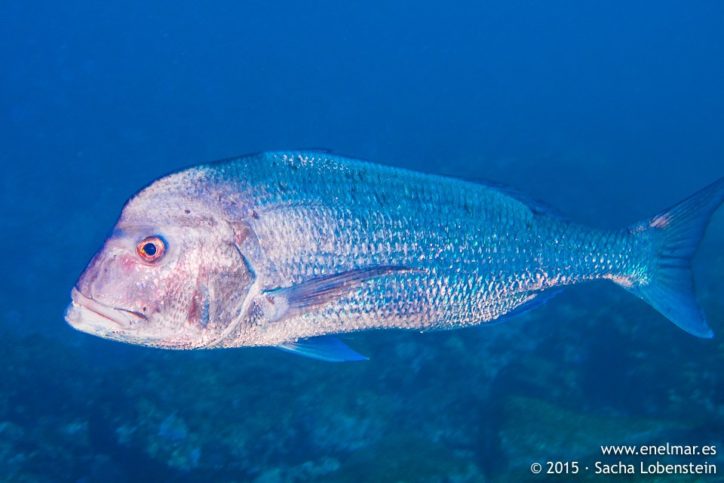
(Pink dentex, an adult specimen. Photo by © Sacha Lobenstein. enelmar.es)
The pink dentex feeds on squid, crustaceans, fish, like its relative, but rarely swims to the shores. However, young fish are often found in large deep sea bays and should be treated carefully, they should be released. Besides, they have an obvious difference from other sea breams – the first soft spines on the dorsal fin grow much longer than the others.
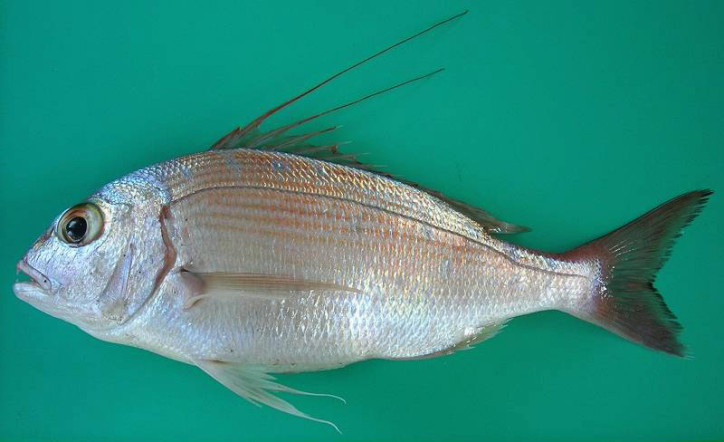
(Pink dentex, a young specimen. Photo by © Akın Türker İlkyaz. ilkyaz.eu)
Not so long ago, ichthyologists finally made a decision and ranked pickarels as sea breams. Two species of pickarels are regularly caught by the Adriatic fishermen: the pickarel and the blotched pickarel.
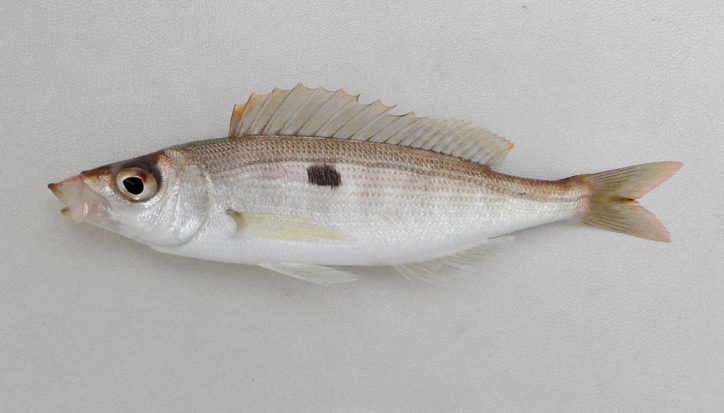
(Pickarel. Photo by © Theo Modder. fishbase.org)
Pickarels are small fish 20-25 centimeters long. These schooling pelagic species swim closer to the coast mainly in the off-season. They are caught both with float gear (they like bread) and with light spinning rod (in this case, pickarels prefer small “edible” silicone lures).

(Blotched pickarel. Photo by © sysbio.univ-lille1.fr)
Other representatives of the sea breams family inhabit the Adriatic Sea as well. But if you are there on vacation, there are few chances to come across them. However, it’s enough to catch fish from other families, adriaticnature will continue the story about them in the next part of the article.